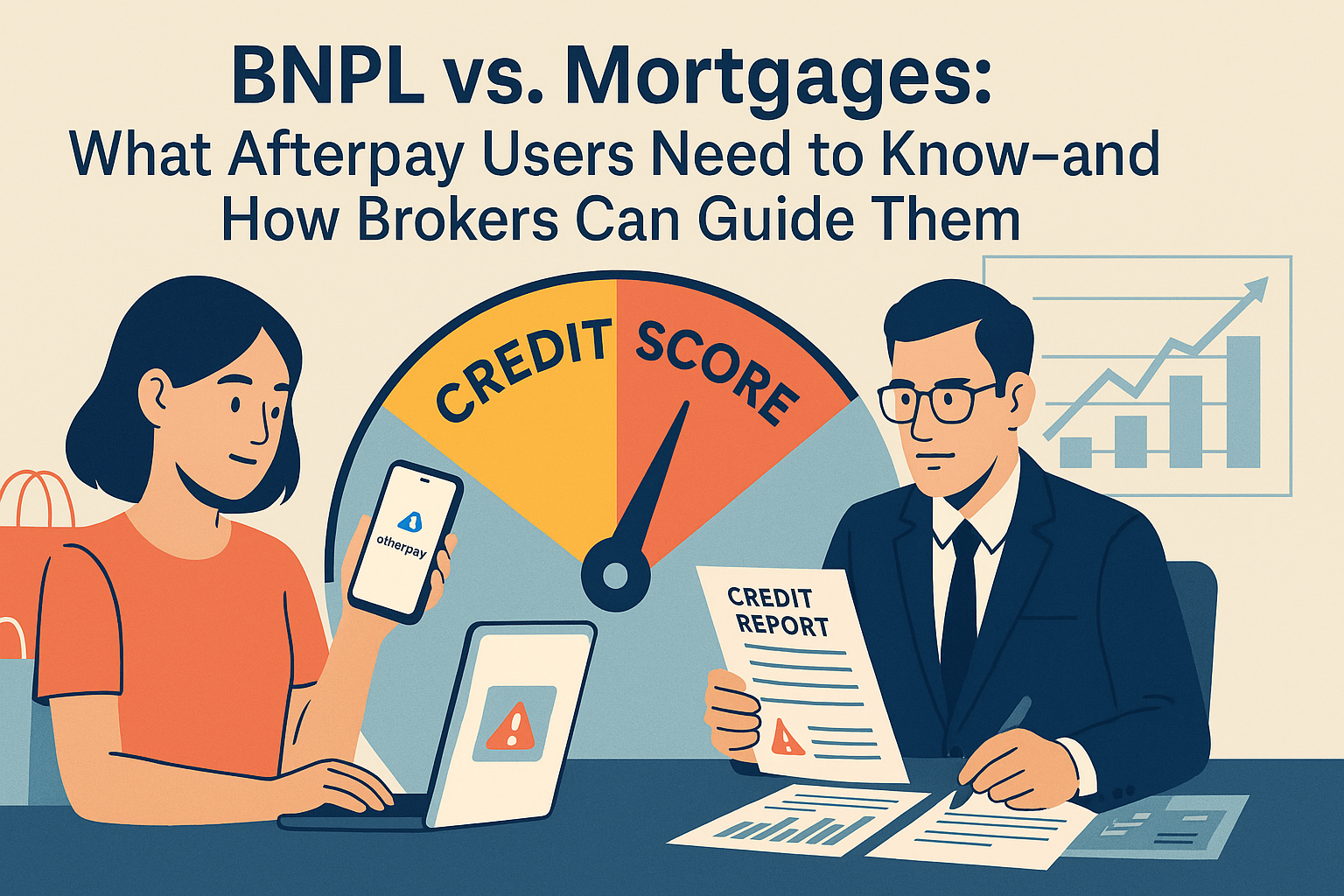Too Busy to Read? We’ve Got You.
Get this blog post’s insights delivered in a quick audio format — all in under 10 minutes.
This audio version covers: Buy Now, Pay Later & Your Mortgage – The Hidden Truth About BNPL’s Impact on Home Loans
BNPL vs. Mortgages: What Afterpay Users Need to Know—and How Brokers Can Guide Them
The rapid rise of Buy Now, Pay Later (BNPL) services like Afterpay has transformed consumer spending, offering a convenient, often interest-free way to manage purchases. However, for aspiring homeowners, this perceived convenience can create significant, often unforeseen, hurdles when applying for a mortgage. This article aims to cut through the noise, clarifying the real impact of BNPL on mortgage eligibility and equipping Australian mortgage brokers with the essential knowledge and actionable strategies to guide their clients effectively through this evolving landscape.
The increasing adoption of BNPL services has introduced a new layer of complexity for individuals pursuing significant financial goals, particularly homeownership. Many users initially embraced BNPL for its ease of access and the perception that it operated outside traditional credit scrutiny, often marketed with phrases like "no credit checks".[1, 2] This widespread belief, however, overlooks the deeper implications for a consumer's credit profile and overall borrowing capacity. The core challenge for the financial services sector, and for mortgage brokers specifically, lies not merely in the existence of BNPL, but in the prevalent lack of understanding among users regarding its evolving regulatory status and its profound impact on their mortgage readiness.[3] This knowledge gap underscores the critical role of the mortgage broker as an essential source of clarity and expertise in a financial environment that is becoming increasingly intricate.
In This Guide
The Shifting Sands: BNPL's New Regulatory Landscape
Until recently, Buy Now, Pay Later services largely operated outside the traditional credit regulatory framework in Australia. This allowed them to offer quick approvals with minimal or no formal credit checks, contributing to their rapid popularity.[1, 2, 4] This era of largely unregulated operation has now concluded. As of June 10, 2025, new Australian legislation has fundamentally reshaped how BNPL is classified, regulated, and consequently, how it impacts a consumer's financial standing.
Key Regulatory Changes (Effective June 10, 2025)
The new legislative framework introduces several critical changes that brokers and their clients must understand:
- Credit Product Classification: BNPL is now officially categorized as a 'low cost credit' product under the National Consumer Credit Protection Act 2009 (NCCP Act).[4, 5] This represents a significant reclassification, bringing BNPL in line with other traditional credit products in the eyes of regulators and, increasingly, lenders.[3]
- Australian Credit Licence: All BNPL providers, including major players like Afterpay and Klarna, are now legally required to hold an Australian Credit Licence.[3, 5, 6] This ensures a higher level of oversight and accountability within the industry.
- Responsible Lending Obligations: Providers must now comply with responsible lending rules, similar to other traditional lenders.[3, 5, 6] While the obligations are modified to be less onerous for 'low cost credit contracts' (LCCCs) compared to standard credit, they still mandate affordability checks before approving new accounts or increasing limits.[1, 4] This means providers will now inquire about a customer's income, expenses, and other liabilities, a process previously often bypassed. This increased scrutiny could potentially lead to a higher chance of rejection for financially stressed individuals.[5]
- AFCA Membership: BNPL providers are now mandated to join the Australian Financial Complaints Authority (AFCA) if they are not already members.[3, 5, 6] This provides a formal dispute resolution mechanism for consumers.
- Hardship Support: Providers are required to offer formal hardship support processes, providing a safety net for customers experiencing financial difficulties.[3, 5]
- Credit Reporting Requirements:
- Credit Checks for Applications: Providers are now required to perform a credit check when a customer applies to become a BNPL customer.[5]
- Hard Checks for Limit Increases: A 'hard credit score check', which is recorded on the customer's credit report, is now required when customers apply to increase their BNPL credit limit.[5]
- Reporting Defaults: Critically, missed payments or defaults on BNPL accounts can now be reported to credit bureaus, directly impacting a client's credit score.[1, 3, 5, 6] Such negative listings can remain on a credit file for up to five years.[6]
- Comprehensive Credit Reporting (CCR): On a more positive note, if a BNPL provider participates in Comprehensive Credit Reporting (CCR), consistently making on-time repayments can actually improve a customer's credit score.[5] However, it is important to note that CCR is not yet universally applied across all providers.[5]
- Facilities over $2,000: BNPL providers offering products with a credit limit over $2,000 are required to participate in the credit reporting system (Principles of Reciprocity and Data Exchange - PRDE), meaning they will both access and contribute BNPL data to credit reports.[3]
- Facilities under $2,000: Smaller BNPL facilities (those with a credit limit under $2,000) are not covered under the same comprehensive reporting rules. This means brokers may still need to rely on thorough bank statement analysis or direct client disclosure to uncover this type of debt.[3]
The fundamental shift is that BNPL is no longer "invisible debt." It is now a regulated credit product, and its usage will increasingly impact a client's credit profile and borrowing capacity, just like traditional loans.
The new regulations introduce a complex dynamic where increased transparency, while generally beneficial, also exposes clients' previously unscrutinized spending habits to lenders. This creates a situation where the solution—greater visibility of BNPL activity—simultaneously reveals new challenges for clients whose past financial behaviours, once hidden, now become formal assessment points for mortgage applications.[6, 7, 8] For brokers, this means gaining better data, but also facing the task of explaining to clients why their previously "harmless" BNPL usage is now a significant factor.
Furthermore, the distinction in reporting requirements between BNPL facilities over and under $2,000 creates a practical two-tiered system for assessment.[3] For larger BNPL debts, brokers will benefit from clearer, more formal data via credit reports, which can streamline some aspects of their assessment. However, for smaller, more frequent BNPL usage—which can still signal problematic spending habits or a reliance on short-term credit [8]—brokers will continue to rely heavily on manual bank statement analysis and direct client disclosure. This means that while the industry anticipates some streamlining, diligent due diligence by the broker remains critical, especially for uncovering the very habits that often lead to unexpected rejections by lenders.
Beyond the Score: How Lenders Scrutinise BNPL Usage
While a client's credit score provides a snapshot of their creditworthiness, mortgage lenders delve far beyond this single metric to assess a borrower's true financial discipline and long-term ability to service a mortgage. They conduct a rigorous "strict stress test" that often isn't factored into generic online mortgage calculators.[8] This involves a deep dive into bank statements to understand day-to-day spending habits and financial obligations, seeking a holistic view of a client's financial behaviour.[2, 6, 7, 8]
Reuters Findings: The "Close Your Account" Dilemma
A significant Reuters report highlighted a concerning trend within the Australian market: some customers of Afterpay were explicitly told by banks or mortgage brokers to close their BNPL accounts as a condition to qualify for a mortgage.[9] Compounding this, Afterpay claimed that these same customers were subsequently offered a credit card by the very institution that had advised them to close their BNPL account.[9]
Afterpay suggests that traditional banks might be strategically leveraging a perception of BNPL users as riskier than traditional borrowers. This, according to Afterpay, is a tactic to protect a declining lending category, particularly as interest-accruing credit card debt in Australia has fallen significantly over the past half-decade.[9] Afterpay argues that its users' credit scores and on-time repayment records are broadly in line with those of credit card users.[9] According to Afterpay's Head of Public Policy, Michael Saadat, this practice of advising account closures is often driven by a "misperception of the regulatory requirements" rather than a genuine necessity.[9]
This situation reveals a strategic tension in the market. Traditional lenders may be using BNPL as a proxy for what they perceive as "poor financial discipline" or "reliance on short-term credit," even if objective credit scores do not fully support this view. This approach allows them to potentially de-risk their mortgage portfolios or even encourage consumers back towards their more profitable traditional credit products, like credit cards. Brokers find themselves in a position where they must navigate this lender perception while also providing accurate, unbiased advice to their clients. This means focusing not just on technical compliance, but also on the overall financial presentation and lender appetite.
Hidden Spending Patterns and Key Red Flags for Lenders
Lenders are increasingly focused on the subjective impression of a client's financial responsibility and stability. Even if a BNPL account is technically paid on time, frequent small transactions or a pattern of reliance on short-term credit can create an "optical" issue for a lender, signaling a higher risk profile. This means brokers need to advise clients not just on what is technically compliant or debt-free, but on what looks good and demonstrates robust financial management to a lender. It is about presenting a clear and disciplined financial narrative.
Beyond the formal credit report, lenders scrutinise bank statements for various behavioural indicators:
- BNPL Mispayments: Even seemingly minor mispayments, such as a single missed $40 repayment on a BNPL service, can raise significant red flags with banks.[8] Most borrowers are unaware that their BNPL usage is monitored at such a granular level.[8]
- Frequent BNPL Usage: Beyond just missed payments, extensive or frequent use of BNPL services can be viewed by lenders as a risk factor, potentially signaling a reliance on short-term credit for everyday expenses rather than robust budgeting.[6]
- Multiple Active Accounts: Having too many active BNPL accounts, even if managed, can be difficult for clients to track and budget for, raising concerns for lenders about overall financial management.[1, 6]
- Cash Withdrawals: Lenders view frequent or large cash withdrawals, particularly at locations like casinos or pubs, negatively, as they can signal risky financial behaviour.[7, 8]
- Subscriptions and Payment Services: All recurring subscriptions and payment services visible on bank statements can influence how banks perceive a client's financial habits and disposable income.[8]
- Lifestyle Spending: Seemingly minor lifestyle splurges, such as frequent brunches or excessive online shopping, can quietly erode borrowing power by reducing a client's demonstrable disposable income.[8] Lenders assess what a client can repay, not just how much they have saved.
- Defaults and Dishonoured Payments: Any past defaults on loans or dishonoured payments remain in a bank's internal systems and can lead to a "silent no" from that bank and potentially other lenders, even if not immediately visible on a standard credit report.[8]
- Overdrawn Accounts: Frequently overdrawing accounts is a clear sign of poor account behaviour that can sabotage an application from within the bank's risk systems, even if the client's credit score is otherwise intact.[8]
- Too Many Applications: Applying to multiple lenders in a short period can trigger a "silent no" from banks, as it may indicate desperation or a higher risk profile.[8]
Lenders are looking for holistic financial discipline and stability. Any pattern of spending that suggests reliance on short-term credit, poor budgeting, or inconsistent financial management can negatively impact an application, often regardless of a clean credit score.
Navigating the New Rules: What June 2025 Means for Your Clients
The previous, often-cited understanding that BNPL "won't affect your credit score" and "isn't technically recorded on your credit report" [2] is now largely outdated due to the sweeping regulations effective June 10, 2025. Brokers must clearly communicate this fundamental shift to their clients, dispelling old myths and setting new expectations. The transition means that what was once a casual payment method now carries formal credit implications, and clients whose past casual use could unexpectedly impact their future mortgage eligibility need to be prepared for this significant behavioural shift.
Mandatory Affordability Checks
Under the new framework, BNPL providers are now required to conduct affordability checks before approving new customers or increasing existing credit limits.[1, 3, 5] This means they will inquire about a client's income, expenses, and other liabilities, a process previously often bypassed.[5]
Credit Reporting and Your Client's Score
The impact on a client's credit score is a crucial aspect of the new regulations:
- Hard Checks Now Common: Applications for new BNPL accounts and requests for credit limit increases will now trigger 'hard credit checks'. These inquiries are recorded on a client's credit report and can temporarily reduce their credit score.[5, 6]
- Defaults Impact Score: Crucially, any missed or defaulted BNPL repayments can now be formally reported to credit bureaus. This will directly and negatively impact a client's credit score, and such adverse listings can remain on their credit file for up to five years.[1, 5, 6]
- Positive Reporting (CCR): On a more positive note, if a BNPL provider participates in Comprehensive Credit Reporting (CCR), consistent on-time repayments can actually improve a customer's credit score.[5] Brokers should be aware that not all providers currently participate in CCR for positive reporting.[5]
Implications for Borrowing Power
The formal recognition of BNPL as credit has direct consequences for a client's borrowing capacity:
- Increased Liabilities: BNPL accounts, now formally recognized as credit, add to a client's overall debt obligations. Lenders factor these liabilities into their assessment of a client's financial capacity.[6]
- Reduced Disposable Income: The regular installments required by BNPL services directly reduce a client's disposable income. This significantly impacts serviceability calculations, which determine how much a client can genuinely afford to repay on a home loan.[6]
- Risk Factor: Extensive or frequent BNPL usage may be viewed by lenders as an elevated risk factor, potentially signaling a reliance on short-term credit for everyday expenses.[6] Lenders will factor BNPL spending into home loan approvals.[1]
Table: BNPL Regulations & Mortgage Impact
This table concisely summarises the critical regulatory changes and their direct, practical implications for mortgage applicants. It serves as an invaluable, quick-reference guide for brokers, enabling them to explain complex information clearly and efficiently to time-starved clients.[10, 10] By visually highlighting the dramatic shift from the pre-regulation landscape to the post-June 2025 reality, the table makes the impact undeniable and easy to grasp, directly supporting the need for clear policy and compliance updates.[10]
| Aspect of Regulation | Pre-June 2025 Landscape | Post-June 2025 (Effective 10 June 2025) | Mortgage Impact for Clients |
|---|---|---|---|
| Classification | Unregulated credit (often) | 'Low Cost Credit' under NCCP Act [4, 5] | Formal debt, impacts serviceability [6] |
| Credit Licence | Not required | Required [3, 5, 6] | Increased oversight, more formal assessment |
| Responsible Lending | Not applicable | Required (modified obligations for LCCCs) [3, 4, 5, 6] | Affordability checks (income, expenses, liabilities) [1, 5] |
| AFCA Membership | Not required | Required [3, 5, 6] | Consumer protection, dispute resolution |
| Credit Checks | Often none/soft checks [1, 2] | Required for applications; hard checks for limit increases [5, 6] | Direct impact on credit score [1, 5, 6] |
| Defaults Reporting | Generally not reported [2] | Can be reported, impacting credit score [1, 3, 5, 6] | Negative credit history, remains for 5 years [6] |
| Positive Reporting (CCR) | Limited/None | Possible if provider participates [5] | Potential for positive credit history building |
| Visibility to Lenders | Primarily via bank statements [2] | Bank statements + credit reports (for >$2k facilities) [3, 6] | Comprehensive financial footprint |
The complexity of the new regulations, including distinctions between modified and standard obligations, negative and partial credit checks, and varying CCR participation, creates a significant knowledge gap for consumers. The Mortgage & Finance Association of Australia (MFAA) highlights that many borrowers remain "unaware that BNPL impacts their credit profile".[3] This underscores a critical need for brokers to translate this complex regulatory jargon into actionable advice for clients. This goes beyond mere compliance; it presents an opportunity to provide substantial value and build trust by demystifying a confusing financial landscape for clients.
Your Role as a Broker: Guiding Clients Through the BNPL Maze
As a broker, your role extends beyond simply finding the right loan; it involves being a trusted advisor who helps clients navigate complex financial landscapes. Proactively educating clients on BNPL's impact is now a significant competitive advantage.[3] The confusion surrounding BNPL and the potential for "silent black-listing" by lenders creates considerable anxiety for clients.[3, 8, 9] Brokers who proactively educate clients and guide them through this maze, rather than waiting for issues to arise, can build immense trust.
Pre-Application Advice for BNPL Users
To prepare clients for a mortgage application in the current environment, consider advising them on the following:
- Reduce or Eliminate BNPL Use: Advise clients to significantly reduce or pause BNPL activities for at least 3-6 months before applying for a mortgage.[1, 7] This demonstrates responsible spending habits and improves their financial footprint in the eyes of lenders.[6, 7] This action helps clients present a clear and disciplined financial narrative.
- Consolidate Debts: If clients have multiple BNPL accounts or other small, outstanding debts, suggest consolidating them. While a consolidation loan itself is a form of debt, managing one loan responsibly can improve their credit score and simplify their overall financial picture for lenders.[2]
- Monitor Credit Score and Report: Encourage clients to regularly check their credit score (e.g., via Canstar) and obtain a free credit report.[2, 6, 11] This helps them understand how BNPL transactions appear and identify any reported defaults or inquiries that could affect their application.
- Clean Up Bank Statements: Advise clients to review their bank statements for any "red flag" spending patterns, such as excessive small transactions, gambling, or frequently overdrawn accounts, and adjust habits where necessary.[7, 8] This holistic approach to financial health prepares their entire financial profile for lender scrutiny.
- Limit Active Accounts: Too many active BNPL accounts, even if managed responsibly, can raise red flags for lenders, making it harder for clients to track and budget repayments effectively.[1, 6] Advise clients to limit the number of active accounts.
- Avoid Late Payments: Emphasise that late BNPL payments can now directly impact their credit score, potentially leading to negative listings that remain on their credit file for years.[1, 5, 6]
Managing Expectations During Application
Brokers play a vital role in setting realistic expectations and addressing common misconceptions:
- Full Disclosure: Stress the importance of full transparency regarding all BNPL accounts, even if they are small or appear to be paid off.[6] Lenders will see this activity on bank statements regardless, and attempting to conceal it can be detrimental to the application.[2]
- Challenging Misconceptions: Address the Reuters finding head-on.[9] While some clients may be told by others (including some banks or brokers) to close all BNPL accounts, clarify that it is a misconception that all accounts must be closed for approval, especially if they have been managed responsibly.[2, 6] The key is demonstrating responsible management and overall serviceability, rather than simply eliminating an account.
- Focus on Serviceability: Explain that BNPL, as a liability, reduces disposable income and affects serviceability calculations. The ultimate goal is to demonstrate a client's capacity to comfortably repay the mortgage, not just to eliminate BNPL from their financial picture.[6]
Leveraging Data and Workarounds
The new regulations offer both increased visibility and ongoing challenges for brokers:
- Increased Visibility: Utilise the new credit reporting data for BNPL facilities over $2,000.[3] This provides a clearer picture of larger liabilities and streamlines the assessment process for these accounts.
- Manual Scrutiny for Smaller Facilities: For BNPL facilities under $2,000, which may not be fully reported under the new comprehensive rules, continue to perform thorough bank statement analysis and direct client disclosure.[3] This ensures that even smaller, potentially problematic spending patterns are identified and addressed.
Your ability to translate complex regulatory changes and lender expectations into clear, actionable advice will be paramount in helping clients achieve their homeownership dreams.
The broker's role has expanded to that of a "financial hygienist," guiding clients on a holistic financial preparation strategy. This involves not just advising on BNPL, but on cleaning up bank statements, monitoring credit, and adjusting discretionary spending.[2, 6, 7, 8] This pre-application conditioning of the client's financial behaviour adds significant value to the broker's service, transforming their role from transactional to a strategic partnership. In an increasingly complex financial landscape, clarity and honest guidance become premium services. By being the source of this clarity, brokers can earn a "trust dividend," leading to stronger client relationships, repeat business, and invaluable referrals.
Conclusion: Empowering Your Clients, Strengthening Your Business
Conclusion: Empowering Your Clients, Strengthening Your Business
The landscape of consumer finance is continually evolving, and the integration of BNPL into formal credit regulation marks a significant milestone. For Australian mortgage brokers, this isn't just a compliance update; it's an opportunity to deepen client relationships and reinforce your value proposition. By understanding the nuances of the new BNPL rules, recognizing how lenders truly assess financial conduct, and proactively guiding clients, you can transform potential roadblocks into pathways to homeownership.
Get More InsightsThe entire discussion highlights how BNPL, if not managed effectively, can introduce significant risks for mortgage applicants, including reduced borrowing power, negative credit score impacts, and the triggering of various lender red flags. The proactive guidance provided by a broker directly mitigates these risks. This underscores the broker's crucial role as a "risk mitigator" for their clients in the context of mortgage applications. By helping clients navigate the complexities of BNPL usage, brokers are actively reducing the chances of loan rejection and potential financial hardship, thereby solidifying their indispensable role in the home loan journey.
This perspective also reframes regulatory changes, which often feel like an additional burden, into a strategic advantage for brokers.[10] Instead of viewing compliance with new BNPL rules as merely an administrative task, brokers can strategically leverage their expertise in this area to provide superior client service. This transforms a potential industry challenge into an opportunity for business growth, aligning perfectly with the objective of providing "Broker Growth & Tools".[10] By embracing this evolving landscape, brokers not only empower their clients to achieve their homeownership dreams but also strengthen their own businesses through enhanced trust and differentiated service.






